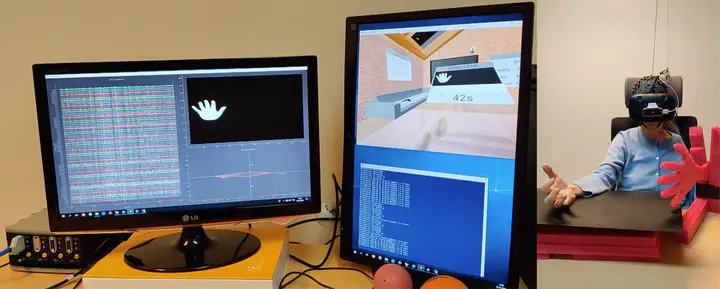GHOST -- Coupling Brain-Computer Interfaces with Virtual Reality to deliver neurofeedback to patients' suffering from neuropathic diseases
 The GHOST prototype in action.
The GHOST prototype in action.The GHOST project is a joint project between École Centrale de Nantes (Jean-Marie NORMAND, Saïd MOUSSAOUI) and Nantes’ Hospital (CHU de Nantes, Vincent ROUALDES, Aurélien VAN LANGHENHOVE).
Summary:
This project is a collaboration between:
- the Nantes University Hospital’s “Pain and Neurosurgery” team, namely Vincent ROUALDES, neurosurgeon and Aurélien VAN LANGHEHOVE, research engineer,
- Jean-Marie NORMAND, Associate Professor in VR, École Centrale de Nantes,
- the “SIMS” team from École Centrale de Nantes, specialized in signal processing, namely with Saïd MOUSSAOUI.
In GHOST, we propose a system coupling Brain-Computer Interfaces (BCI) and VR in order to treat neuropathic pain such as phantom limb pain or pain due to a cerebral vascular accident by offering patient VR neurofeedback based on Mental Motor Imagery.
The proposed system consists of a therapeutic action where the patient is immersed in a Virtual Environment where s/he sees in a first person (1PP perspective) the integrated representation of his/her limbs. The healthy limb can be controlled in order to provide synchronous Visuo-Motor stimulations. The measurement and real time analysis of EEG signals allows us to detect the mental Motor Imagery and to animate the affected limb accordingly. The patient thus receives immediate (neuro)-feedback in response to the Mental Motor Imagery process.
Indeed, our research hypothesis is that a system offering real-time neurofeedback consistent with a Mental Motor Imagery task will allow to modify the cerebral plasticity of patients and reduce their neuropathic pain. This hypothesis is based on results that have already shown that visualization of limb movement activates (via the mirror neuron mechanism) the same areas of the sensorimotor cortex as imagination of an identical movement. Furthermore, imagining a movement while visualizing movement of the same limb (e.g., imagining the movement of one’s hand while visualizing the movement of another hand) increases the activation of areas of the sensorimotor cortex corresponding to that limb. Finally, recent work showed that the use of neurofeedback in immersive VR resulted in more regular brain wave patterns and simpler spatial features to classify than when using “classical” neurofeedback on a screen.